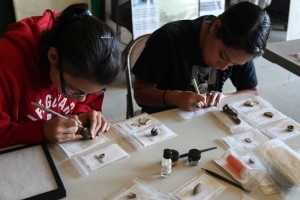Artifact Analysis
Dr. Rubén G. Mendoza, PhD
Description: This lab exercise provides an overview of those methods and procedures entailed in basic artifact identification and analysis. Because of the archaeologically significant role of ceramics in cultural and temporal identifications, and the relative dating of site deposits, this exercise will have as its objective the identification of ceramic types relative to the California missions. It is anticipated that by way of processing existing collections, and using available ceramics catalogs, handbooks, and project manuals, you will come away with a basic introduction to how one goes about identifying and describing each of the primary ceramic types and traditions represented in the existing collection. In this exercise, you will once again be reintroduced to a template derived from technical writing, however, in this instance, the template is structured for descriptions of ceramics and other related artifacts. The formula provided in the template for structuring a description will be used in any and all instances in which data entry “descriptions” are created for the catalog.
Elements of Ceramic Typology: (a) surface treatment, (b) material composition, (c) slip or glaze color and or type, (d) functional type, (e) style, (f) manufacturer, where known, (g) functional or morphological elements, (h) overall form, (i) relative or absolute dimensions, (j) temper, (k) raised, printed, or painted decorative elements, (l) technological or stylistic tradition, (m) makers marks, and (n) date of manufacture where known.
Descriptive Narratives: Ceramic descriptions and descriptors from: Sussman, Lynne. 2000. British Military Tableware, 1760-1830. In Approaches to Material Culture Research for Historical Archaeologists, 2nd Edition. David R. Brauner, Compiler. California, Pennsylvania: The Society for Historical Archaeology.
“Creamware plate with brownish-red banded decoration and transfer-printed insignia (overglaze) of the 13th regiment…”
“Salt-glaze stoneware platter with molded relief decoration using basketry motifs.” “Pearlware plate in shell-edge pattern.”
“Pearlware saucer with blue underglaze painted decoration…[and]…chinoiserie “house” pattern.” “White earthenware plate in the Willow pattern.”
“Pearlware saucer with underglaze polychrome painted decoration.”
Lab Exercise: Using the attached Template for Artifact Descriptions, and the available lab manuals for ceramic types, you are to identify and describe a range of different ceramic specimens drawn from the collections. Having perfected your respective descriptions for a range of ceramic types, you will prepare a very concise, albeit accurate and complete, description suitable for use with the project database. You should make use of the following strategy:
1. Retrieve the specimen from its container and take care to keep the specimen with its original bag tag.
2. Examine the characteristics of the specimen as per the “Elements of Ceramic Typology” noted above
and record your assessments in your notes.
3. Use the lab manuals and catalogs to identify the specific specimens under study.
4. Use the Munsell Soils book to identify the exact color of the specimen as per the typology therein.
5. Having collected the necessary information, you should now prepare to use the attached template to fully, albeit, concisely, describe the specimens under scrutiny.
6. Return specimen and bag tag to their original container and enter description into the database.


